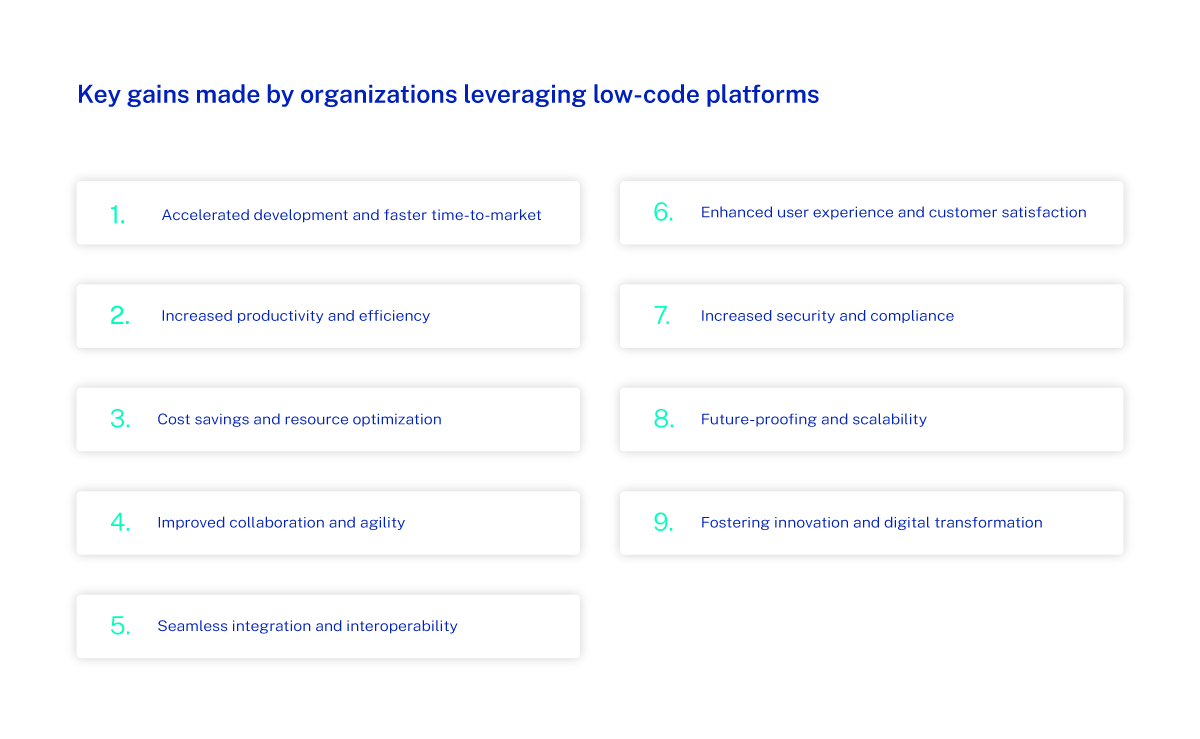- Accelerated Development and Faster Time-to-Market
- Increased Productivity and Efficiency
- Cost Savings and Resource Optimization
- Improved Collaboration and Agility
- Seamless Integration and Interoperability
- Enhanced User Experience and Customer Satisfaction
- Increased Security and Compliance
- Future-Proofing and Scalability
- Fostering Innovation and Digital Transformation
In a competitive global marketplace, speed has arguably never been more important when it comes to developing new products. This is partly to gain first-mover advantage with new solutions and meet transformation goals, but also to overcome the slow and expensive nature of software development that can hold agility and reactive evolution back.
Previously, the key to fast development without compromising product quality was to hire expert developers. But these are now so scarce and expensive that they’re out of many businesses’ reach. However, a more viable solution has emerged: low-code software development, using visual development tools, drag-and-drop interfaces and more to put development skills in the hands of those without detailed coding expertise.
Organizations already leveraging low-code platforms are making real gains in several key areas of their development processes:

 Accelerated Development and Faster Time-to-Market
Accelerated Development and Faster Time-to-Market
Low-code platforms enable rapid and high-quality application development through a combination of visual development tools, streamlined processes and reduced coding efforts, all of which can help shorten release cycles. It’s worth making the point that low-code does not replace the need for software developer expertise - but it does cut down on the amount of developers and expensive resources required.
 Increased Productivity and Efficiency
Increased Productivity and Efficiency
A low-code framework that enables Rapid Application Development (RAD) means that developers can achieve more each day, and be able to work on more projects over a period of time. Furthermore, it also enables the rise of ‘citizen developers’ who can use some of their time to minimize IT backlogs, and provide further resources at times of intensive workloads or tight deadlines.
 Cost Savings and Resource Optimization
Cost Savings and Resource Optimization
Being able to develop applications faster and more efficiently can help generate substantial savings. This is partly due to lower staffing bills thanks to shorter time frames, and also because of the reduced need for expensive expertise mentioned above. Low-code platforms are also helpful for enabling more efficient resource allocation and easier scalability, as they deliver more flexibility around who does what, where and when.
 Improved Collaboration and Agility
Improved Collaboration and Agility
By being able to bring more members of staff directly into the development process, low-code enables wider team collaboration across functions, which in turn supports a culture of continuous improvement. Combined with the rapid iteration that low-code makes possible, it means that teams can work together and turn initial concepts into tested, functioning applications extremely quickly.
 Seamless Integration and Interoperability
Seamless Integration and Interoperability
Most good low-code platforms contain a range of built-in connectors and features around usability, which means that they can seamlessly integrate with external systems and features. This can be a real game-changer when trying to run business processes seamlessly across multiple enterprise platforms and applications, and for fostering collaboration between teams working on different areas concurrently.
 Enhanced User Experience and Customer Satisfaction
Enhanced User Experience and Customer Satisfaction
Low-code makes it easier to create tailored and personalized applications, thanks to a range of customization options that can be added easily and quickly. This is also supported by the general speed of development, too: instead of having to worry about the complexity of coding, development teams can put more focus on customer requirements and overall objectives instead.
 Increased Security and Compliance
Increased Security and Compliance
Low-code platforms are built with security front-of-mind, including built-in user role provisioning and encryption features. These support the creation of quality applications without the risk of any security vulnerabilities along the way, which can be crucial in areas such as Banking, Financial services and Insurance (BFSI). In an era of tightening data protection regulations and increasing compliance demands, this can also make a real difference in governance and reporting.
 Future-Proofing and Scalability
Future-Proofing and Scalability
Many applications need regular updates and enhancements, and low-code platforms are perfectly suited to a continuous approach to optimization. New features and integrations can easily be added to existing applications without having to leverage expert IT resources at short notice. This can be instrumental in adapting to evolving business needs, and making solutions scalable for growth and expansion.
 Fostering Innovation and Digital Transformation
Fostering Innovation and Digital Transformation
Connected to the previous point, when low-code platforms generate efficiencies and enable rapid optimization and improvement, development teams are in a stronger position to experiment and be creative. In a world where speed-to-market is so important, this can make the difference in driving forward digital transformation initiatives.
Ciklum’s approach to low-code applications can give you a stronger platform to innovate and get new products to market faster. Take a closer look at how we can help you here.

































